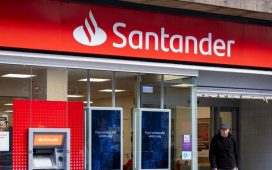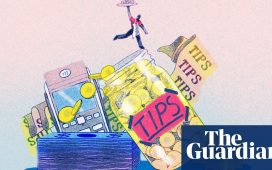Young woman feeling concerned about grocery prices on the bill in the supermarket.
Lordhenrivoton | E+ | Getty Images
Many shoppers have been shocked by what they pay at the grocery store checkout.
Food prices shot up amid broader inflation in recent years, and remain high for many staples.
As consumers struggle with elevated food costs that can lead to unpaid debt balances.
Many families dipped into their savings or turned to credit cards, buy now, pay later installment programs or payday loans to pay for groceries in 2023, according to new research from the Urban Institute.
While those payment methods can be a lifeline, they may also lead to financial instability.
“The rate of price increases is slowing, but households are still paying more today for groceries than they did last year,” said Kassandra Martinchek, senior research associate at the Urban Institute.

“That might mean that folks are having to rely on liquidity sources other than their income to be able to meet their very basic needs, their food needs,” she said.
It’s not just those who are most financially disadvantaged who are experiencing these challenges, according to Martinchek.
Expiring pandemic aid, inflation affect grocery bills
Consumers have been grappling with higher food prices since 2021. For some, coping with those costs has been more difficult as pandemic-era aid expired. Enhanced allotments to Supplemental Nutrition Assistance Program, or SNAP, benefits expired in March 2023, leading the average individual to receive about $90 less in benefits per month.
About 70% of all grocery transactions are through credit or debit cards, the research found. Those payment methods carry risks, especially for consumers who can’t pay off the balance in full.
More from Personal Finance:
Average consumer carries $6,218 in credit card debt
Here’s the inflation breakdown for April 2024 — in one chart
Some vacationers expect to carry summer travel debt
In 2023, the average annual percentage rates for credit cards rose to 22.8%, the highest rate on record, according to the Urban Institute.
“When that unused credit limit is there in front of you, sometimes it looks like a lifeline,” said Bruce McClary, senior vice president at the National Foundation for Credit Counseling. “In some circumstances, that lifeline is really a cinderblock.”
Grocery charges can lead to missed payments
While 33.4% of adults who used a credit card for groceries repaid the charges in full, 20% of adults paid less than the full balance but always paid the minimum payment. Meanwhile, 7.1% did not make the minimum payments.
Households with greater levels of food insecurity were more likely to use payday loans, buy now, pay later programs or savings to pay for basic needs, according to the Urban Institute.
Of those who used buy now, pay later for groceries, 37% of adults missed payments on those loans.
Adults with lower levels of food security were also likely to experience debt repayment challenges.
Certain policy changes could help alleviate those struggles, according to the Urban Institute research, such as increasing SNAP and other social safety net supports; expanding financial options to help families in need and making credit counseling and debt-management services more broadly available.
Individuals and families who are currently struggling can take steps to help avoid turning their grocery store visits into lasting debt balances.
By shopping with cash instead of credit, that can help limit spending to an exact amount, McClary said.
For debtors who feel stuck, talking to a nonprofit credit counseling agency can help with budgeting and managing debt, he said.
“If you can’t do it yourself, somebody’s there to help,” McClary said.










